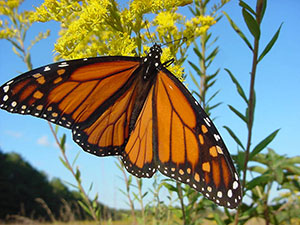A Tribute To The Monarch Butterfly: How to Turn Your Backyard Into a Butterfly Friendly Habitat
by Hermann Samano of Porch.com
 Iconic is the most appropriate word to describe the Monarch butterfly. Most of us have fond childhood memories of the unmistakable orange and black beauty flitting around the blue sky on sunny summer days. They were everywhere - and their presence was so magnificent. Their name, in Greek, means "sleepy transformation" in recognition of their ability to hibernate and metamorphize - and if you've ever watched it happen through a glass jar, you understand why.
Iconic is the most appropriate word to describe the Monarch butterfly. Most of us have fond childhood memories of the unmistakable orange and black beauty flitting around the blue sky on sunny summer days. They were everywhere - and their presence was so magnificent. Their name, in Greek, means "sleepy transformation" in recognition of their ability to hibernate and metamorphize - and if you've ever watched it happen through a glass jar, you understand why.
If you've been feeling like you don't see as many Monarch butterflies as you remember seeing 5, 10, or 20 years ago, you're not imagining things. Loss of habitat, along with pesticides and the eradication of the Monarch butterfly's host plant (Milkweed), has resulted in Monarch butterflies becoming endangered.
When we hear about an endangered species, it's hard not to feel helpless and insignificant. But, unlike with many endangered species, you - yes, you! - hold real power to make a positive difference in protecting the Monarch butterfly and helping their populations thrive right in your own backyard. Here are some easy ideas to get you started. Let's make a positive difference together!
How to attract and keep Monarchs in your butterfly garden
Helping Monarch butterflies to thrive in your garden requires some basic knowledge of their life cycle and migration paths so that you know how to support them through these two journeys they take in their lifetime. You will also need some ideas for garden layouts and plants they love.
The Monarch butterfly life cycle
- The Monarch life cycle begins when the female Monarch butterfly lays her eggs individually on separate milkweed leaves.
- A few days later, the eggs hatch into the larva stage, which gives us the Monarch caterpillar.
- The Monarch caterpillar needs to grow as much as possible in the next two weeks, so it feasts on the only thing it eats - milkweed.
- Fully fed for the next phase of its life, the caterpillar enters the pupa stage by hanging upside down from a plant stem and spinning a protective chrysalis around itself.
- A couple of weeks later, the caterpillar emerges from the chrysalis as a fully-formed, adult Monarch butterfly.
- If it isn't time to migrate, adult butterflies immediately begin the Monarch life cycle again - that is, after they find a meal of nectar from pollinator plants nearby.
This is where you come in. So, let's get our hands dirty and learn how to create a butterfly-friendly garden!
Plant Milkweed
Grow milkweed for the Monarch butterflies and Monarch caterpillars to eat, and they will come. Plant milkweed in full sun, in groups of at least six plants, or those hungry, hungry caterpillars will run out of food. Water your plants sufficiently so they stay healthy. That is how they will produce sufficient nectar, for all those amazing butterflies that will start to visit your garden. Also:
- Avoid the use of pesticides and opt for natural solutions when possible.
- Provide landing pads near water sources so the butterflies can drink safely (mud puddles are ideal since they allow the butterflies to get necessary minerals from the soil, too.)
- Create safe spaces for the butterflies to roost at night, like trees and shrubs Position large, flat rocks in the sun so that the butterflies can warm themselves in order to be able to fly again.
- Trim plants carefully - there might be a life cycle in progress under a leaf!
- Avoid using peat-based compost.
- Go the extra mile, and register your garden as a Monarch Waystation.
Click here to read this article in its entirety.



